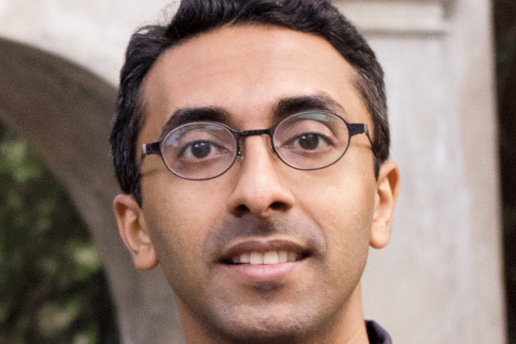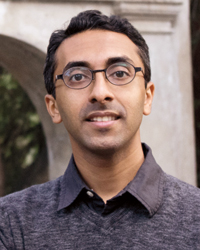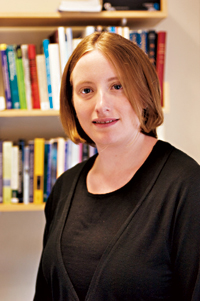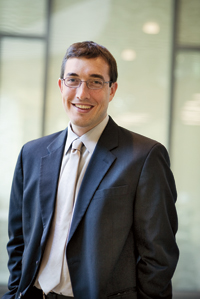
MITEI sat down with four new energy faculty to find out what brought them to MIT and what they plan on researching now that they’re here.

Yogesh Surendranath. Photo: Karthish Manthiram
Yogesh Surendranath
Assistant professor in the Department of Chemistry
Just a few years ago, Yogesh “Yogi” Surendranath was an MIT graduate student working on ways to use excess electricity from solar and wind systems to produce hydrogen for later power generation. This fall, he returned to campus as an assistant professor after spending two years as a Miller Postdoctoral Fellow at the University of California at Berkeley. Surendranath looks forward to continuing his research into finding more efficient and longer-lasting renewable energy storage techniques. He’s also excited to inspire young people at a formative age when they’re making decisions about what types of science to pursue. His first crop of mentees: undergraduate students taking advanced inorganic chemistry.
How is the energy landscape changing, and what should we do about it?
Today, we’re in the midst of a dramatic paradigm shift in how we think about energy in our societies. In the not-so-distant future, electricity from renewable energy sources such as wind and solar will—at certain times in the day—be cheaper than the fuel we dig out of the ground and burn. But this renewable energy can only be harnessed if we can develop efficient, cost-effective, energy-dense methods for its storage and later utilization during times of peak demand. We need to realize that the transition to a renewable energy economy will not occur overnight and there will be no single magical solution. Making the transition will require consistent, long-term funding and sustained work by both policy makers and researchers.
How does your research support that paradigm shift?
There are lots of technologies that can take electrical energy, store it in chemical bonds, and then discharge it when we need it. In all of them, a critical role is played by processes at interfaces, where electrons are doing the needed chemistry. My group works at the molecular level to understand those processes so we can design surfaces as well as catalysts to selectively and efficiently achieve the desired reactions. If we can develop systematic strategies for doing this, we can move to the next generation of technologies, for example, a lithium air battery with ten times greater energy density or an electrolyzer that can take carbon dioxide from waste streams and—using wind or solar energy—convert it to another fuel source.
How has your experience at MIT affected your perspective as a scientist?
The high level of motivation and optimism here really sets MIT apart from other institutions and makes it a very inspirational environment, especially for work in the energy space. The MIT Energy Initiative [MITEI] has created a culture where it is very clear that energy research is supported and has strong institutional backing—one of the assets that drew me to the Institute. As a researcher here, I’ve learned that it’s foolhardy to believe we can act in a vacuum without knowing the constraints of scale and cost faced by industry. Connecting researchers with global energy companies—as MITEI does—exposes us to these design constraints. That’s important because our role as scientists is not only to think of the most innovative solution but also the solution that is simplest, most cost-effective, most scalable, and most durable. That is a different sort of thinking than what academic scientists are used to. Being at MIT, both as a graduate student and now as a professor, has helped me realize that innovative technologies will remain an academic curiosity unless they are designed with a deep appreciation for the real-world challenges they target.

Noelle Selin. Photo: Patrick Gillooly, MIT
Noelle Selin
Assistant professor in the Engineering Systems Division and the Department of Earth, Atmospheric, and Planetary Sciences
Noelle Selin’s professional interests have always centered on the intersection of policy and the environment. During her undergraduate training at Harvard University, she pursued an interdisciplinary major in environmental science and public policy. She also worked on toxic chemicals issues for the US Environmental Protection Agency and spent a year as a Fulbright fellow with the European Environment Agency. But to really make an impact, Selin felt she needed deeper knowledge. After earning her PhD in atmospheric chemistry from Harvard University, she found the perfect fit performing interdisciplinary research at MIT. From engaging with state and national air pollution regulators to briefing delegates during international negotiations, Selin constantly designs her research to be responsive to the needs of policy makers and strives to communicate her results effectively. She is currently part of the Stanford-affiliated Leopold Leadership Program for mid-career academics, where she is honing her skills in designing and communicating research related to the environment and sustainability.
You’re currently working on a MITEI seed grant project. What are your goals in this research?
Recently, there have been a lot of air quality improvements that may have altered the background chemistry of the atmosphere. If we don’t account for those changes when evaluating current and future regulations, we may end up with regulations that are less effective than predicted. To help in such analyses, Susan Solomon of earth, atmospheric, and planetary sciences, John Reilly of the MIT Joint Program on the Science and Policy of Global Change, and I are creating a dynamic model that can quickly show which pollutants to reduce to get the biggest benefits. We’re beginning our research by looking at the US, but the model could easily be applied to other regions, and we hope to use it to examine air quality in the context of climate policy.
What’s been involved in making your model a useful tool for policy makers?
The real challenge for all modelers in this area is to represent the complexity of the atmosphere and to take uncertainties into account in a rigorous way, while also obtaining results that are simple and specific enough to help policy makers. We’re designing the model to confront this tension without making it too complicated and time-consuming to run. We’re doing so by taking key elements from different complex models and deciding what’s needed to approach the actual probelm in the environment. Then we’re piecing all the most useful information together into one model.
What methods do you use to teach your students how to make their research relevant to policy?
I encourage students to think critically about how to bring knowledge to action by engaging them in current policy discussions. For example, during last year’s Independent Activities Period [at MIT], I took a group of students to the international mercury negotiations in Geneva, Switzerland. Each student was assigned a mercury-related topic and asked to blog about the latest developments in that area. This fall, my class is taking a virtual field trip via webcast to the climate negotiations [at the Conference of the Parties] in Warsaw, Poland, and the class assignments are blog posts where students give scientific assessments, issue summaries, and updates on the negotiations. My goal is to get students to think about what science is relevant to policy development and how to communicate it, so they can be engaged in the policy-making process.
View Selin’s mercury blog and her climate blog.

Alexie Kolpak. Photo: Jim Miller
Alexie Kolpak
Assistant professor in the Department of Mechanical Engineering
As a postdoctoral associate at Yale, Alexie Kolpak was looking for something new. She started scanning the American Physical Society abstract book for interesting research, and MIT Professor Jeffrey Grossman’s name kept popping up. Kolpak connected with Grossman and soon accepted a postdoctoral position in his group. Along with providing valuable research opportunities, Grossman taught Kolpak the fundamentals of running a research group—knowledge she has put to work since becoming an assistant professor at MIT last fall. With funding from a MITEI seed grant, Kolpak is now working on a process to make carbon capture and storage (CCS) more economically feasible. She’s also looking at ways to make solar cells more efficient and to split water molecules to turn hydrogen into fuel.
What drove you toward this career path?
In high school, I had never thought about science until, ironically, I did an English paper on biotechnology. I thought it was so fascinating and wanted to dig deeper, but I still wasn’t convinced it was for me. In college, I toyed with becoming an English major while also taking biochemistry classes. I found myself asking questions like, “Why does that happen? Why does this reaction occur? Why does this structure form the way that it does?” I was really eager to learn more about processes at the atomic scale. Once I got to MIT, I realized we could actually have a big impact on a lot of important technologies and societal issues if we could use the knowledge we were gaining at this scale to develop smart materials and put them to use in a realistic way. That has become an exciting driver for me.
How are you working to improve the CCS process?
I’m working on a technique that would chemically alter surfaces to make CO2 react with the surface and produce a useful product. This could be used, for example, in cars. Exhaust could come through a converter that captures the CO2 and changes it into methanol. Then the methanol would feed into another tank to use for fuel. On a larger scale, this same type of process could be used in power plants to help make CCS more economically feasible because the process would create usable products like cyclic carbonates, which are used in plastics and as solvents. Making CO2 into something useful, rather than simply treating it as waste, would offset the cost of implementing the technology.
With your research based in chemistry, how did you end up in the mechanical engineering department?
That’s one of the things I love about MIT. There aren’t really lines between disciplines. People here understand that a very interdisciplinary approach is needed to solve these types of all-encompassing global challenges. My research is a perfect example. Usually, you wouldn’t associate the work I’m doing with mechanical engineering. But it’s becoming a lot more important to actually understand what’s happening at the atomic scale. To give a clear example, though not from my own research, when you think of concrete, you think of it as a building material, but it produces 5% of CO2 emissions. So people are looking at the chemistry of concrete to try to develop new ways to make it so that it doesn’t produce that much pollution. So chemistry is directly linked to the more traditional mechanical engineering. By being part of the mechanical engineering department, I’m learning things I never would have thought about if I hadn’t been in this department. It’s opening up lots of new directions.

Christopher Warshaw. Photo: Stuart Darsch, courtesy of MIT Department of Political Science
Christopher Warshaw
Assistant professor in the Department of Political Science
When Christopher Warshaw graduated from Williams College with an economics degree, he expected to take a couple years off before continuing his education in economics. But after doing cost-benefit analyses in an environmental consulting firm, he realized that smart economics wasn’t driving policy; politics was driving policy. To learn politics from the ground up, he went to work on campaigns for two years before deciding to pursue a PhD in political science. Now, Warshaw is analyzing the political forces behind policy development and the role public opinion plays.
Why did you decide to come to MIT, and how do you hope to make a difference here?
The collaborative work happening at MITEI and throughout campus that brings together scientists and engineers is really exciting. Working with engineers, and in this engineering culture, influences our work to the extent that the political science department here really focuses on applied research much more than at many other top-notch programs. Applying my research to policy is something that’s really important to me.
The engineering mindset also influences the students. The students are really motivated to find solutions to real problems. At the same time, I think it’s important for students to be exposed to a wide variety of perspectives because it’s been my experience working in politics, nonprofits, and government that smart people can rise really fast. The students here are brilliant; we just need to give them the right training and expose them to the complexities of these issues. And if we do, I believe they can really make a difference very quickly in the world.
What drove you to this research?
Climate change has always been one of my main drivers. Part of confronting that challenge means thinking about how we can use cleaner sources of energy. Underlying that is an economic challenge: How can we keep power affordable and allow our economy to keep going forward? But when I was at the consulting firm, I realized there was a lot more to confronting the climate challenge than determining the smart economic choices. To contribute to positive changes in the world, I needed to understand more about how the world works. That led me to political science research. While most of my work addresses broad issues, the methodological tools and new statistical techniques can be applied to specific energy and environmental issues.
What are the research questions you’re looking to solve, and what have you found out so far?
My main research questions are: What is it that causes us to end up with the types of policies that we have? How well do those policies represent public opinion? And, if people are to be effective advocates and effective citizens, how can they get involved and make a difference? In applying these questions at a national level, I’ve found that it’s hard to get legislators to vote against their partisan priorities. In fact, it takes vast shifts in public opinion to change legislators’ roll call votes. Applying this research to the energy sphere is a challenge because there isn’t enough survey data to actually know what people want, especially at a local level. For example, you’d expect that in Wyoming people are pro coal, but we don’t actually know because there are no surveys of public opinion on environment and energy at the local level. So in the future, I’d like to run surveys to measure public opinion on specific energy policies. This will enable me to look at the relationship between public support for specific policies and the policies that states actually implement.
This article appears in the Autumn 2013 issue of Energy Futures.